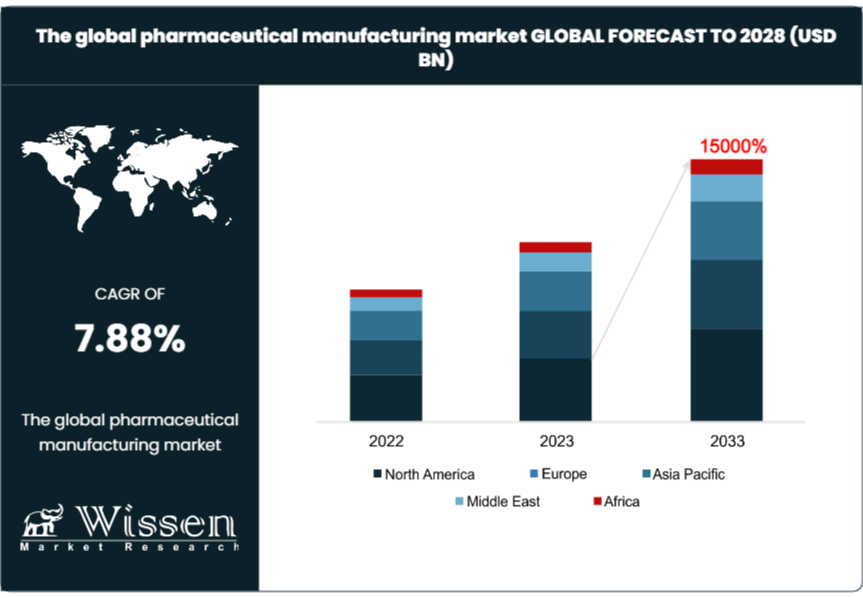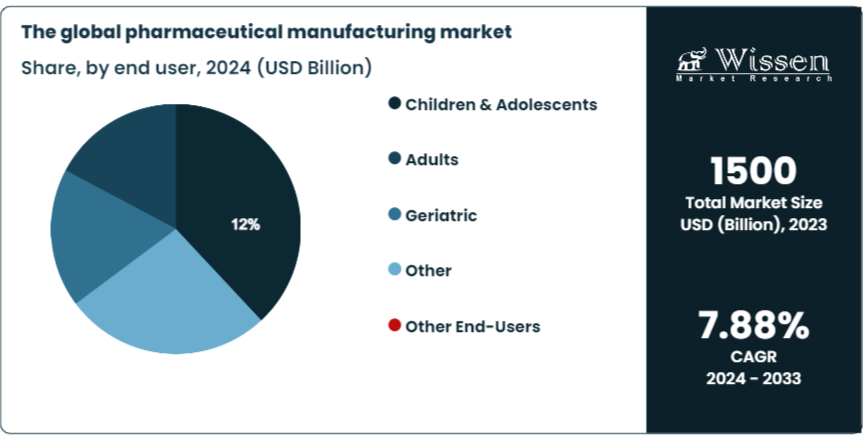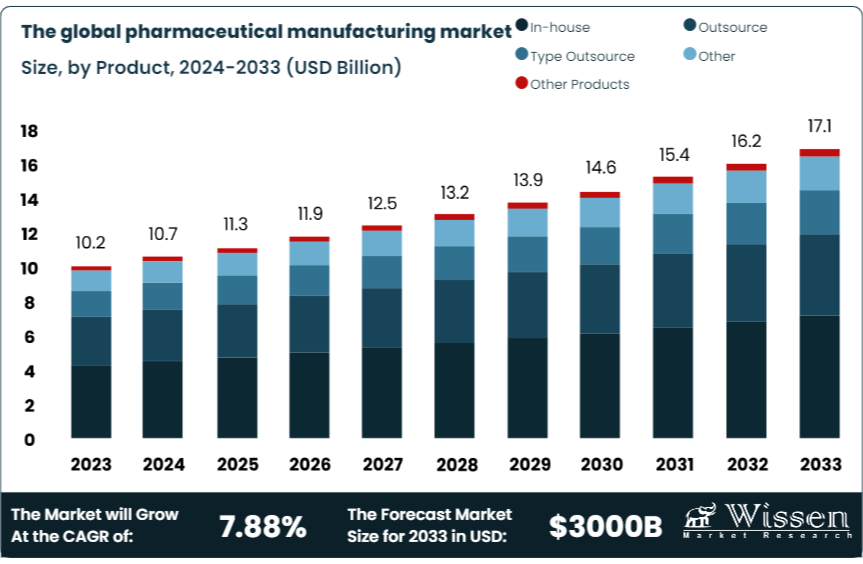
The global pharmaceutical manufacturing market
Pharmaceutical Manufacturing Market: Trends and Share by Drug Development Type (In-house and Outsource), by Formulation (Tablets, Capsules, Injectable, Sprays), by Molecule Type (Biologics and Biosimilars, Conventional Drugs), by Route of Administration (Oral, Topical, Parenteral, Inhalations), by Therapy Area (Cardiovascular Diseases (CVDs), Pain, Diabetes, Cancer, Respiratory Diseases), by Age Group (Children and Adolescents, Adults, Geriatric) and Regions – Forecasts 2033
The global pharmaceutical manufacturing market was valued at USD 559.42 billion in 2023. It is predicted to grow at a CAGR of 7.43% over the forecast period. (2024-33)
The process of creating pharmaceutical drugs on a big scale, known as pharmaceutical manufacturing, usually entails the creation, manufacturing, and distribution of drugs. Strict regulations and quality control standards must be followed during this intricate process to guarantee the efficacy and safety of the pharmaceutical products. The production of pharmaceuticals is a highly developed and strictly regulated sector essential to the global supply of safe and effective drugs for patients.
It also entails formulating, developing, and producing active pharmaceutical ingredients (APIs). Extensive supervision is maintained throughout manufacturing to ensure compliance with regulatory guidelines and high-quality standards, including Good Manufacturing Practice (GMP). Research, scaling up, producing APIs, producing drugs, quality assurance, packing, and distribution are important phases. The objective is to create high-quality, safe, and useful pharmaceuticals for a broad range of applications.

Dynamics
Driver
The demand for pharmaceutical products is rising due to factors such as the aging population, the prevalence of chronic illnesses, and the increase in global population. Increased capacity for manufacturing pharmaceuticals is therefore necessary. The demand for pharmaceuticals is rising globally, which is driving up manufacturing. The aging population, growing incidence of chronic illnesses, and expanding population all increase the need for pharmaceuticals.
The demand for pharmaceutical products is rising due to factors such as the aging population, the prevalence of chronic illnesses, and the increase in global population. Increased capacity for manufacturing pharmaceuticals is therefore necessary. The demand for pharmaceuticals is rising globally, which is driving up manufacturing. The aging population, growing incidence of chronic illnesses, and expanding population all increase the need for pharmaceuticals.
In response, pharmaceutical companies increase their production capabilities to meet the healthcare system's demands and guarantee a steady supply of necessary medications. This trend aligns with initiatives to improve access to drugs, address new public health concerns, and improve global health outcomes. As a result, it will impact strategic investments and developments in pharmaceutical manufacturing technologies and procedures.
Restraint
Strict adherence to regulations in pharmaceutical production is a vital component meant to guarantee the security, effectiveness, and caliber of pharmaceuticals. Health authorities and agencies around the world enforce these regulations in order to protect public health. In pharmaceutical manufacturing, Good Manufacturing Practices (GMP) and Quality Management Systems (QMS) are two essential components of strict regulatory compliance. Pharmaceutical product manufacturing, testing, and quality control are governed by GMP regulations, which offer a set of guidelines.
Manufacturing processes are guaranteed to be standardized, under control, and to satisfy the relevant quality standards when they comply with GMP. But, in order to guarantee that every step of the manufacturing process is methodically monitored and recorded, pharmaceutical manufacturers must put in place extensive quality management systems. Tight regulations and compliance standards are necessary to guarantee the safety of products, but they can also cause problems for manufacturers because of higher operating costs and longer approval processes.
Opportunities
Pharmaceutical manufacturers must prioritize maintaining adaptability and ingenuity to exploit these opportunities, adapt to evolving market conditions, and address advancing healthcare challenges. Companies can strategically position themselves in the pharmaceutical manufacturing market by engaging in collaborations, making targeted investments, and undertaking research and development initiatives. Allocating resources towards digitalization, robotics, and automation has the potential to enhance overall productivity, reduce expenses, and optimize production processes.
Furthermore, the exploration of innovative manufacturing techniques enhances the ability to increase size, adaptability, and production efficiency. The pharmaceutical industry derives advantages from these investments and research endeavors as they augment their overall expansion and competitiveness, enabling them to comply with regulatory standards, manufacture superior products, and address novel healthcare challenges.
Get more details on this report -
Drug Development Type
Pharmaceutical manufacturing includes the processes involved in developing new drugs for a range of medical conditions. In the ever-changing world of pharmaceutical manufacturing, pharmaceutical companies frequently contract development and manufacturing organizations (CDMOs) to handle drug development. Businesses can take advantage of specialized knowledge, cut expenses, and accelerate development with outsourcing. With flexibility and scalability, CDMOs offer services from large-scale manufacturing to clinical trials and formulation development. By using this strategic approach, pharmaceutical companies can accelerate drug development, effectively respond to market demands, and concentrate on their core competencies while gaining access to external capabilities.
Formulation
In the pharmaceutical manufacturing industry, tablet formulation is an essential part of drug development. It entails developing a dosage form that is both stable and efficient for oral use. To create tablets, excipients like binders and disintegrants are mixed with active pharmaceutical ingredients (APIs) during formulation. The optimal drug release, bioavailability, and patient compliance are the goals of the process. Formulation decisions are influenced by factors such as patient needs, desired release profile, and API characteristics. Tablet quality is ensured by thorough testing. Creating tablets that are safe, effective, and easy for patients to take is essential to providing pharmaceuticals.
Molecule Type
Small molecules, or conventional drugs, make up a sizable portion of the drug development market in the pharmaceutical industry. These substances, which have a low molecular weight, are made into tablets, capsules, or other dosage forms by formulation procedures. Due to their well-defined structures and tendency to target particular biochemical pathways, small molecules make traditional synthesis or extraction techniques possible. To prove safety and efficacy, their development entails in-depth clinical trials, preclinical testing, and rigorous research. Small molecules are still essential to the pharmaceutical industry, providing well-established and efficacious treatment for a wide range of illnesses.
Route of Administration
In pharmaceutical manufacturing, the oral route is a major drug administration method that involves giving medication orally. Oral formulations, like pills and capsules, are meant to be swallowed, making them convenient and compliant for patients. This pathway permits the gastrointestinal tract to be used for systemic drug absorption. Because it is less invasive than other routes, it is easy to administer and can be used for self-medication. These factors contribute to its widespread use. Stability, bioavailability, and patient acceptability are important factors to take into account when formulating medications for the oral route, which adds to the variety of pharmaceutical products on the market.
Therapy Area
Drug development for cardiovascular therapy is a major area of focus for pharmaceutical manufacturers. Drugs that target conditions like hypertension, heart failure, and atherosclerosis are developed to treat heart and circulatory system disorders. Combination products, biopharmaceuticals, and small molecules can all be found in formulations. Thorough testing for safety and efficacy is necessary when developing cardiovascular drugs. Given the prevalence of cardiovascular diseases throughout the world, developments in pharmaceutical manufacturing are essential to developing novel treatments that enhance patient outcomes and deal with the intricate problems related to cardiovascular health.
Age Group
The specific healthcare requirements associated with aging make drug development for the geriatric age group in pharmaceutical manufacturing imperative. It entails creating drugs that take into account things like changed metabolism, taking several medications, and being more vulnerable to side effects. The main focus of research is on age-related illnesses like frailty, chronic diseases, and cognitive decline. The focus of pharmaceutical production for the elderly includes dosage forms such as tablets that are simple to swallow. Assuring the development of safe and effective medications in response to the unique needs of the elderly population improves healthcare outcomes for this population.

Regional Analysis
Region-wise, the global pharmaceutical manufacturing market is segmented into North America, Asia-Pacific, Europe, Latin America, and the Middle East and Africa.
North America is a major player in the global pharmaceutical manufacturing scene, primarily consisting of the United States and Canada. The pharmaceutical industry's research, development, and production are all part of the region's highly developed and diverse industry. In particular, the United States is home to a large number of pharmaceutical companies, state-of-the-art research facilities, and sophisticated manufacturing facilities. Moreover, the pharmaceutical manufacturing industry in North America has gained prominence due to several factors, such as a strong regulatory framework, substantial investments in research and development, and an emphasis on technological innovation. The field has set the standard for the development and manufacturing of a wide range of pharmaceuticals, from traditional small molecules to innovative biopharmaceuticals.
Furthermore, the pharmaceutical manufacturing industry in North America has been instrumental in responding to international health emergencies, such as the COVID-19 pandemic, by aiding in the development and production of vaccines. Because of the industry's influence that transcends national boundaries, North America is an important participant in the global pharmaceutical market.
The Asia-Pacific area, which includes nations like China, India, Japan, and South Korea, has become a vibrant and quickly expanding center for the production of pharmaceuticals. Reduced production costs, a trained labor force, and an increasingly advanced infrastructure are advantages for this area. China and India, in particular, play a significant role in the pharmaceutical supply chain. India is a leader in producing active pharmaceutical ingredients (APIs), and these nations can produce generic drugs.
Furthermore, a wide variety of pharmaceutical products, including both small molecules and biopharmaceuticals, are produced in the Asia-Pacific pharmaceutical manufacturing industry. The growth of pharmaceutical manufacturing in the region is attributed to factors such as advancements in manufacturing technologies, large patient populations, and investments in research and development. In addition to meeting regional healthcare needs, the Asia-Pacific market is essential to the global pharmaceutical industry because it supplies drugs to markets worldwide.

Recent News
January 2024 - In a definitive merger agreement, which was announced by Sun Pharmaceutical Industries Limited and Taro Pharmaceutical Industries Ltd, Sun Pharma, Taro's controlling shareholder, agreed to pay US$43.00 per share in cash, interest-free, for all of Taro's outstanding ordinary shares, excluding those that it already owns or its affiliates.
October 2023 - 51 pharmaceutical companies have been approved by the Indian government to participate in the Production Linked Incentive (PLI) Scheme. This scheme is a crucial measure to advance and reinforce India's bulk drug manufacturing sector. Its approval signifies a noteworthy achievement in the country's endeavor to decrease its reliance on imported pharmaceutical ingredients. Uma Magesh, an Under Secretary in the Department of Pharmaceuticals for the Government of India, declared this statement, highlighting the government's dedication to enhancing the Indian pharmaceutical sector.
Segmentation
Molecule Type Outlook
Biologics & Biosimilars (Large Molecules)
- Monoclonal Antibodies
- Vaccines
- Cell & Gene Therapy
- Others
- Conventional Drugs (Small Molecules)
- Monoclonal Antibodies
- Drug Development Type
- In-house
- Outsource
- In-house
- Formulation
- Tablets
- Capsules
- Injectable
- Sprays
- Suspensions
- Powders
- Other Formulations
- Tablets
- Route of Administration
- Oral
- Topical
- Parenteral
- Inhalations
- Other Routes of Administration
- Oral
- Therapy Area
- Cardiovascular Diseases (CVDs)
- Pain
- Diabetes
- Cancer
- Respiratory Diseases
- Other Diseases
- Cardiovascular Diseases (CVDs)
- Age Group
- Children & Adolescents
- Adults
- Geriatric
- Children & Adolescents
- Regional Outlook
- North America
- U.S.
- Canada
- U.S.
- Europe
- UK
- Germany
- France
- Italy
- Spain
- Sweden
- Norway
- Denmark
- UK
- Asia-Pacific
- China
- Japan
- India
- Australia
- Thailand
- South Korea
- China
- Latin America
- Brazil
- Mexico
- Argentina
- Brazil
- Middle East and Africa
- Saudi Arabia
- South Africa
- UAE
- Kuwait
- Saudi Arabia
- North America
The global pharmaceutical manufacturing market Scope:
| Report Data | The global pharmaceutical manufacturing market Market |
| The global pharmaceutical manufacturing market Forecast 2022 | XX million/billion (2022-2032) |
| The global pharmaceutical manufacturing market CAGR 2022 - 2032 | 7.88% |
| The global pharmaceutical manufacturing market Analysis Period | 2022 - 2032 |
| The global pharmaceutical manufacturing market Base Year | 2021 |
| The global pharmaceutical manufacturing market Forecast Data | 2022 - 2032 |
| Segments Covered | By Type, By Application, And by Regions |
| Regional Scope | North America, Europe, Asia Pacific, Latin America, and Middle East & Africa |
| Key Companies Profiled | IBM, Cisco, Apple, Micr, Bayer, Libbs, 3M. |
| Key Segments | By Type Type 1 By Applications Application1 |
| Report Coverage | Market Drivers, Market Trends, Restraints, Competitive Analysis, Player Profiling, Regulation Analysis |
Frequently Asked Questions
What is the future market value of the The global pharmaceutical manufacturing market?
The current market value for The global pharmaceutical manufacturing market is expected USD XX million/billion by 2022.
What is the CAGR of the Market?
The The global pharmaceutical manufacturing market is to grow at a CAGR of 5.3% during the forecast by 2032.
What is the Market segment?
On the basis of type, the The global pharmaceutical manufacturing market is segmented into Types.
Who are the key players operating in the The global pharmaceutical manufacturing market?
The major players operating in the The global pharmaceutical manufacturing market are Company.
Select Licence Type
Connect with our sales team
The global pharmaceutical manufacturing market
Published Date : Mar 2024 | Formats :Why Wissen Market Research
100%
Customer
Satisfaction
24x7+
Availability - we are always
there when you need us
200+
Fortune 50 Companies trust
Wissen Market Research
80%
of our reports are exclusive
and first in the industry
100%
more data
and analysis
1000+
reports published
till date




